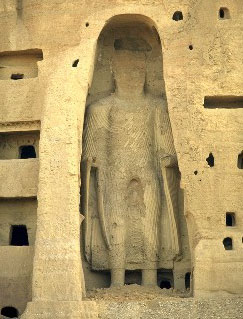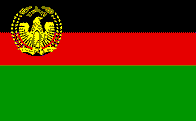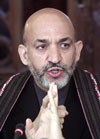



A chronology of key events in Afghanistan history:
 |
| One of the Buddhas of Bamiyan. (AP photo) |
329-326 BCE - Alexander the Great invades Afghanistan. Alexander moved his Macedonian troops over the Hindu Kush into Afghanistan. During the grueling journey, his starving men were forced to eat their pack animals. Afghanistan at that time was composed of satrapies, or provinces, in the Achaemenian Kingdom. Alexander conquered the Achaemenians and most of the Afghan satrapies including Aria (in the region of modern Herat), Bactria (Balkh), Sattagydia (Ghazni), Arachosia (Kandahar), and Drangiana (Seistan). But as soon as he left for India in 327 B.C., Alexander felt his hold on the region slip away as many of the satrapies revolted. After his death in 323 B.C.E., the satrapies passed to the Seleucid Empire.
135 BCE-241 AD - Kushans conquer Bactria. Kushan nomads living in central Asia swooped into Northern Afghanistan and conquered Bactria.It was under the Kushan ruler Kanishka (circa. 130 BCE) that Buddhism started to flourish in the region.
300 - 400 AD - Buddhas of Bamiyan built. Two Buddha statues are carved out of the sandstone cliff-face in the Bamiyan Valley of tBactria. They were destroyed 1,300 years later by the Taliban.
400 AD - White Huns invade. Hephthalites (White Huns) swept into Afghanistan from Central Asia and ruled for 200 years.
Islamic era
652 AD - Arabs introduce Islam in Afghanistan.
962 AD -Ghaznavid Dynasty established. Islamic era begins with the Ghaznavid Dynasty. A Turkish slave called Alptigin marched his armies on Ghazni. Sets up Islamic state. His successors goes on to annex Kabul (977), Bost (977-8), Balkh (994), Herat (1000) and parts of western Persia. Soon Ghazni establishes itself as oneo f the nerve centers of the Islamic world.
1186 - Fall of the Ghaznavid Dynasty. Ghazni is sacked by Alaudin of Ghur. The Ghurids expand their empire with incursions into India.
1219 - Ghengis Khan invades. The great Mongol warrior Ghengis Khan sweeps through Asia. His forces are defeated near Kabul by the Ghurids. Ghengis gets his revenge by razing Ghurid towns.
British invasion
1836 - First Anglo-Afghan War. The British invade Afghanistan
and put a puppet king, Shah Shuja, in power. He is killed three years
later.
1878 - Second Anglo-Afghan War. British try again. This time they were more successful, capturing Kabul and, by the Treaty of Gandamak, establishing the right to maintain a Resident in Kabul. However, after the Resident was murdered, the British withdraw.
1919 - Third Anglo-Afghan War. British forces try once again to bring country under their sphere of influence by assassinating the Afghan King Emir Habibullah Khan. His son and successor, Emir Amanulla Khan, wins independence for people. Amanulla pushes pro-Western reforms in education and gender equity.
1928 - Revolt against Amanolla. Mullahs and religious clerics revolt against Amanulla. Bandit leader seizes Kabul. Amanulla abdicates throne in 1929 and leaves for Switzerland where he dies in 1960.
 |
| Flag of the republic, c. 1973. |
Monarchy in trouble
1933 - Zahir Shah becomes king. Afghanistan
remains a monarchy for next four decades.
1965 - First nationwide elections after consitution introduced.
1973 - Zahir deposed. Mohammad Daoud, Zahir's cousin and former prime minister under the monarchy, overthrows goverment while Zahir Shah on vacation in Europe. Daoud abolishes the monarchy and declares Afghanistan a republic.
1978 - Daoud is overthrown and killed in communist revolt, called the Saur Revolution. Afghan guerrila movement, the mujahedeen, is born after conservative Islamic leaders in the countryside advocate armed revolt. The communist rebels begin fighting among themselves.
1979 - Soviets invade. Pro-communist leaders are appointed and executed in quick succession.
1984 - U.S. sends aid to rebels. The mujahedeen begins receiving military and logistical assistance from the United States and other countries.
1989 - Soviets pull out. Last Soviet troops leave, but civil war continues as mujahedeen push to overthrow pro-communist leader.
1991 - Aid ended. U.S. and U.S.S.R. agree to end military aid to both sides.
 |
| The Taliban flag, c. 1997. |
Rebellious factions fight
1992 - Kabul falls to rebels. The Mujahadeen takeover Kabul and declare
Afghanistan liberated. At least 50,000 are killed in the fighting. The
mujahadeen form an Islamic state, headed by the Islamic Jihad Council
and Prof. Burhannudin Rabbani.
1996 - Taliban take Kabul.They introduce hardline version of Islam, banning women from work, and introducing Islamic punishments, which include stoning to death and amputations. Rabbani flees to join anti-Taleban northern alliance.
2001 -Taliban under attack. Taliban blow up giant Buddha statues in March in defiance of international efforts to save them.
September - Masood, "Lion of Afghanistan," assassinated. Ahmad Shah Masood, legendary guerrilla and leader of the main opposition to the Taliban, is killed, apparently by assassins posing as journalists.
 |
| Hamid Karzai (AP photo) |
October - U.S. launches attack on Taliban. USA, Britain launch air strikes against Afghanistan after Taliban refuse to hand over Osama bin Laden, held responsible for the September 11 attacks on America.
November - Taliban in flight. Opposition forces seize Mazar-e Sharif and within days march into Kabul and other key cities. They finally give up last stronghold of Kandahar in December, but leader Mullah Omar remains at large.
December - Karzai appointd new government leader. Pashtun royalist Hamid Karzai is sworn in as head of a 30-member interim power-sharing government.
2002 - King Zahir returns. Former king Zahir Sha returns but says he makes no claim to the throne.
